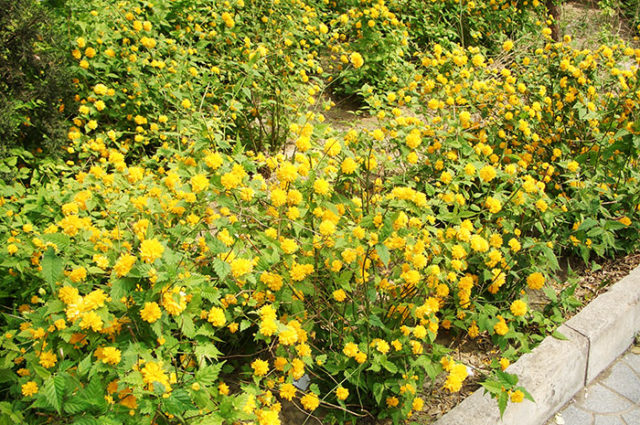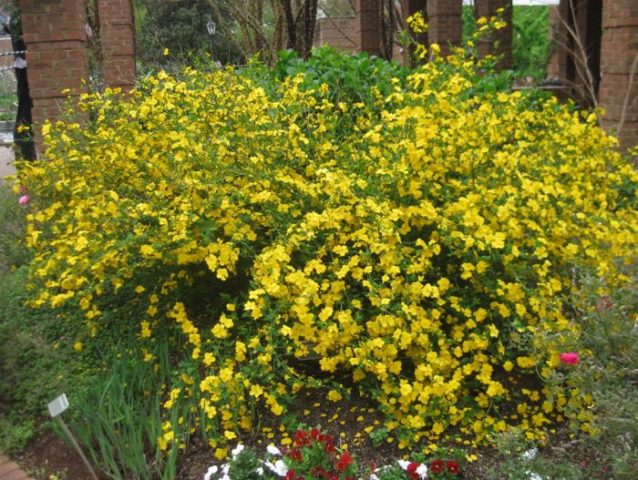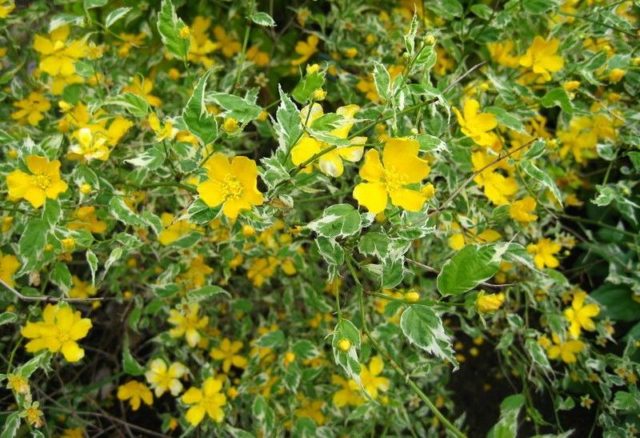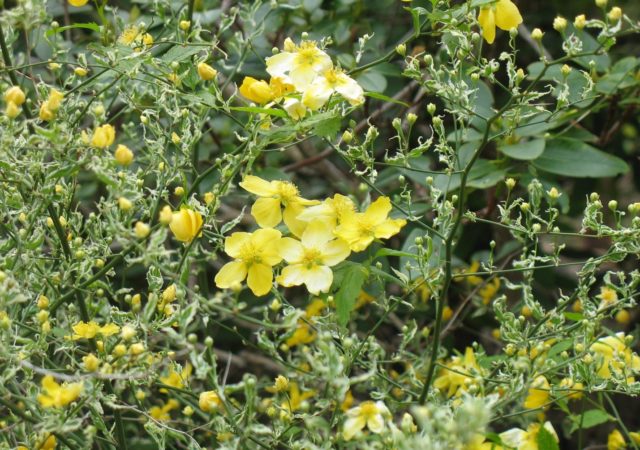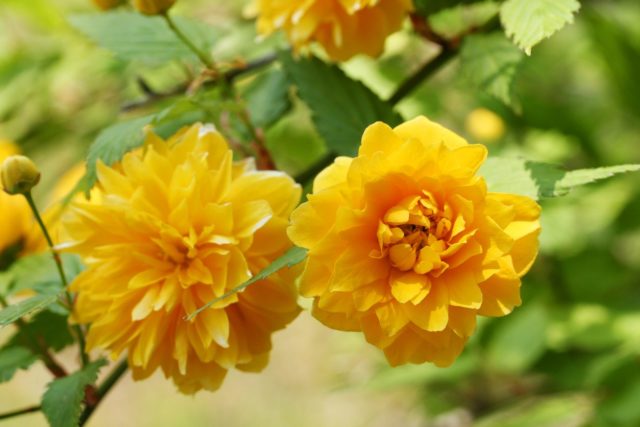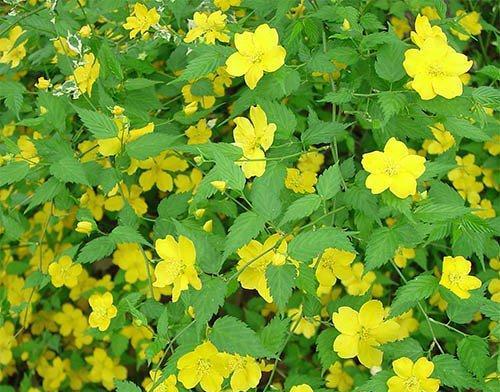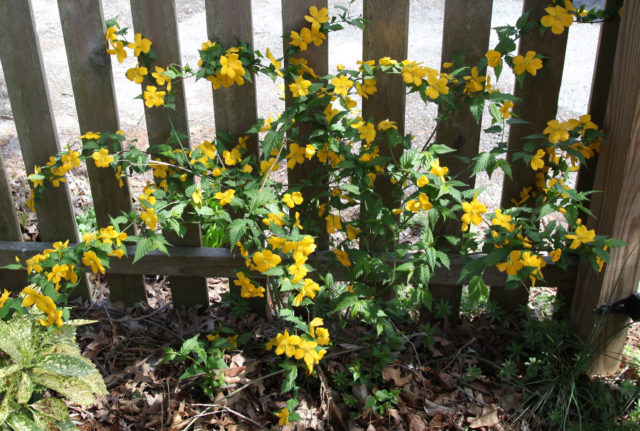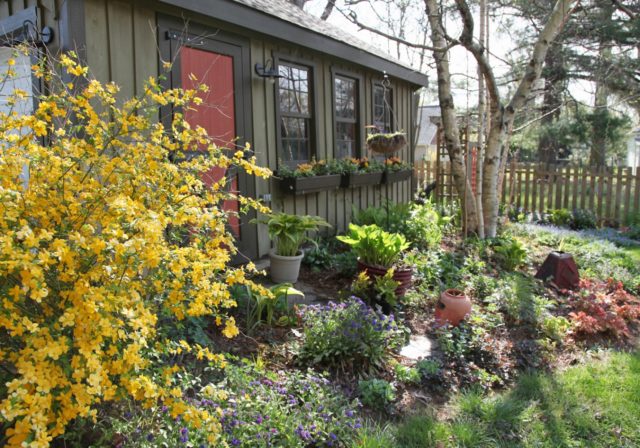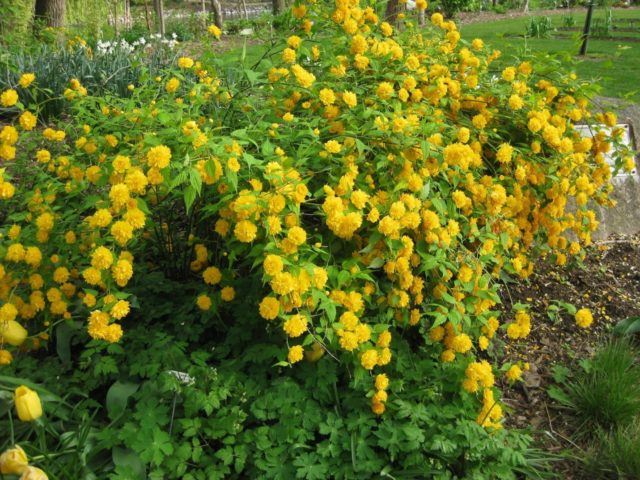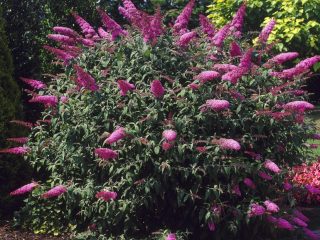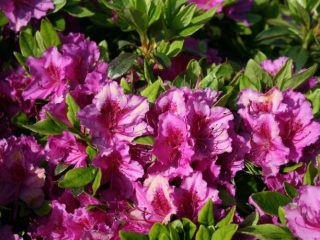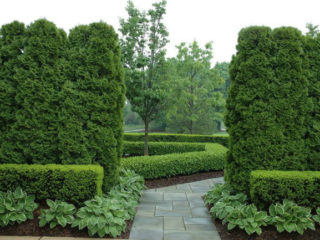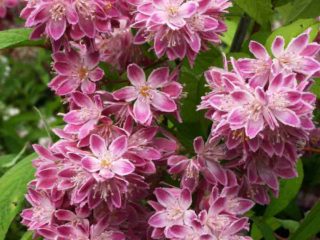Content
- 1 Description of the Japanese kerria shrub
- 2 Winter hardiness of kerria
- 3 Kerria in landscape design
- 4 How kerria blooms
- 5 Features of growing Japanese kerrias in the Moscow region
- 6 Kerria varieties
- 7 Planting and caring for kerries outdoors
- 8 How to breed Japanese kerria
- 9 Diseases and pests
- 10 Conclusion
- 11 Kerria reviews
Kerria japonica is an ornamental, medium-sized, deciduous shrub belonging to the Rosaceae family. The homeland of the plant is the southwestern territories of China and the mountainous regions of Japan. Named after William Kerry, a 19th century gardener at the Royal Botanic Gardens, Kew. The shrub is widespread due to its unpretentiousness, as well as spectacular and long flowering - it forms a large number of bright, lush flowers that resemble small roses, and blooms for about 2 months.
Description of the Japanese kerria shrub
Kerria Japanese is an openwork shrub, the height of which reaches an average of 1-2.5 m, some varieties can grow up to 3 m. The leading quality of the plant is its fast growth, which allows you to experiment with the form of pruning.
The crown of the Japanese kerria has the shape of a cone. The shoots of the bush are erect, twig-like. Their surface is painted in light green tones.
The leaf blade resembles a raspberry leaf in many ways. The length can reach 8-10 cm, lanceolate in shape, serrated at the edges and tapering towards the end. The upper side of the leaf plate is smooth to the touch, and small villi are present on the bottom. The petiole is glabrous, 5-15 mm long. In the summer, the foliage of the kerria is light, pale green, and in the fall the shrub transforms - the leaves acquire a rich yellow hue.
Flowers can be either double or simple - it depends on the specific variety. The average diameter of the flowers is 4-5 cm.
Winter hardiness of kerria
Winter hardiness in Japanese kerrias is average. In the south of the country, where the climate is mild, the bush can be left without shelter for the winter. In conditions of middle latitudes and in the north of Russia, the plant is insulated. It is very important to cover the kerry where there is little snow in the winters.
The peculiarities of the color of the shrub give it a decorative look even in the winter months - the green shoots that give off yellowness contrast perfectly with the white snow.
Kerria in landscape design
The shrub looks equally advantageous both in single plantings and in group compositions, perfectly fitting into the overall picture of a mixed flower garden. The bright flowers of the Japanese kerriya allow you to harmoniously combine it with dark monochromatic conifers: thuja, juniper, spruce. Japanese kerria looks no less impressive as part of curbs and hedges.
Garden crops are among the best neighbors for Japanese kerrias:
- rose flower;
- host;
- spirea (varieties that bloom in the summer months);
- azalea;
- mahonia;
- witch hazel;
- rhododendron;
- hazel;
- vesicle;
- derain;
- bloodroot;
- forsythia.
Separately, it should be noted that Japanese kerria looks good next to ground cover plants: periwinkle, tenacious, phlox.
How kerria blooms
The shrub blooms in late May-early June, there are also late-flowering varieties. The positive qualities of the plant include a lush flowering extended in time - it lasts for 3-4 weeks. Depending on the weather conditions in the region, the duration of the flowering time of the bush may decrease or, conversely, slightly increase.
Sometimes, in especially favorable years, the bushes can bloom again. Although the second bloom will no longer be as abundant, it will still add some decorative effect to the garden.
The fruits of Japanese kerrias are small juicy drupes of dark brown color, obovate or hemispherical in shape, wrinkled, 4.8 mm long. If you grow a shrub in the middle zone of Russia, then the fruits of the plant are not formed.
Features of growing Japanese kerrias in the Moscow region
Caring for Japanese kerry in the Moscow region in spring and summer is not much different from growing shrubs in other regions, but in the fall the plant must be carefully prepared for wintering. Otherwise, the bush will freeze out with the onset of frost, especially if the winter promises to be of little snow.
You can start insulation in October or November, always on a dry, cloudless day.
In the Moscow region, the flowers of the Japanese kerria appear in May, even before the foliage appears. Flowering lasts up to 25 days.
Kerria varieties
The genus of this culture is represented by only 1 species - the Japanese kerria itself. The lack of species diversity is compensated by a large number of varieties. Some of them are popular in Russia.
Pleniflora
Kerria Japanese Pleniflora (Plena, Pleniflora, Flore Plena) is an upright shrub with a dense crown. This variety of Japanese kerria blooms in small double flowers, as seen in the photo below. They reach 3-4 cm in diameter and resemble pompons. They are located singly or 2-3 in the axils of the leaves.
Golden Guinea
Kerria Japanese Golden Guinea is a plant with a graceful leaf shape and fairly large flowers. They reach 6-7 cm in diameter. They are simple in type, not terry.
Variegata (Picta)
Kerria Japanese Variegata or Picta is a variety with flowers that have 5 petals. This variety differs in the decorativeness of the leaf plate - it has a gray-green color and a light stripe along the edge. Also, small cream spots are visible on the surface of the leaf.
In diameter, the Japanese variegata kerry reaches 1-1.5 m, the height does not exceed 1 m. Usually the bush grows up to 50-60 cm in height.
The variegata variety grows very quickly.
Albomarginate
Kerria Japanese Albomarginata is a variety with simple flowers and small leaves. Along the edge, the leaf plate of this variety has a white edging. Among other varieties, Albomarginatu is distinguished by the asymmetry of the leaves.
Aureovariety
Kerria Japanese Aureovariegata (Aureovariegata) is a terry variety of medium height. With good care, the bush grows up to 2 m.If conditions are favorable, the flowering of kerrias of the Aureovariegata variety stretches for 3 months.
Simplex
Kerria Japanese Simplex is a variety with simple flowers. The shrub is in the shape of a ball, it grows in breadth, not upward. Medium-sized bright yellow flowers located in the axils of the leaves. During flowering, the bush looks like a golden ball.
Planting and caring for kerries outdoors
When choosing a place for planting Japanese kerrias, you should adhere to the following tips:
- The shrub loves light and blooms poorly in the shade. In extreme cases, you can plant a crop in partial shade.
- Drafts do not affect the development of the plant in the best way. Better to plant it next to a fence or some structure.
- The best soil type for Japanese kerriya of all varieties is loam. This garden culture does not like dry soils, but wetlands should also be avoided.
The plant is planted in early spring, before the buds appear. Autumn planting is also possible - a month before the onset of cold weather.
To prevent kerria shoots from breaking from the wind, you can plant other flowering shrubs nearby:
- Kuril tea;
- bladderworm;
- spirea.
Coniferous crops will also serve as a good protection.
Preparation of planting material
Japanese kerria seedlings do not need special preliminary procedures. If you wish, you can put them for a couple of hours in a container with water or a special solution that stimulates root growth. So the Japanese kerria will take root better in the open field.
Landing site preparation
The main condition for the lush flowering of kerria is loose loamy or sandy loam soil. If the soil is heavy, dilute it with fine-grained sand. The scanty area is dug up and organic fertilizers are applied.
How to plant Japanese kerria
Landing is carried out according to the following scheme:
- In the selected area, a hole is dug with a depth of about 50-60 cm. The diameter of the hole should correspond to its depth.
- At the bottom of the planting pit, a bucket of compost mixed with garden soil in equal proportions, 100 g of wood ash and 50 g of mineral fertilizer is poured.
- After that, a kerria seedling is lowered into the pit. In this case, the root collar should be at ground level.
- Then the hole is covered with earth and watered abundantly.
- For better moisture retention, the soil under the bush is mulched.
Watering and feeding
Japanese kerria is a moisture-loving plant, but it does not tolerate excess water in the ground. If the water begins to stagnate after heavy rainfall or frequent watering, the roots of the "Easter rose" will begin to rot. To prevent this from happening, during prolonged rains, watering is reduced or completely stopped. If heat and drought sets in, water a little more often, especially during the flowering period.
The frequency of watering is regulated according to the state of the topsoil. The next time the bush is watered when the soil under it is completely dry. If, after watering or rain, a dense crust forms on the ground, the trunk circle is loosened a few centimeters.
Kerrias are fed with organic fertilizers, 2-3 times per season, preferably in late April-early May and in June. Planting responds well to fertilization with rotted compost and horse manure in spring. In the fall, wood ash and complex fertilizers (for example, "Autumn Kemir") are introduced into the soil. About 200 g of ash per 1 m2.
When the flowering ends, an infusion of mullein, diluted in a ratio of 1:10, can be added to the soil.
Kerria trimming
Japanese kerrias are cut for sanitary purposes or to maintain their shape, in order to preserve the decorative effect of the bush. In March or April, you should inspect the bush and remove all damaged shoots: frozen or broken under the weight of snow. To stimulate the branching of the bush, you can additionally cut the remaining branches by 1/3.
When the flowering of the kerria is over, you can start pruning the faded branches to branches that have not bloomed - it is on them that buds will form for re-flowering in the fall.At about the same time, pruning is done in order to rejuvenate the shrub - for this, all shoots over 4 years old are removed. If the crown of the kerria has become too dense, it is thinned out. Since this crop grows very quickly, you can not be afraid to cut too much - the bush will recover as soon as possible.
Shelter of Japanese kerria for the winter
You can start hiding Japanese kerrias for the winter in October. The latest date is the second or third decade of November.
They insulate the plant in dry, cloudless weather.
- Gently bend the shoots to the ground, while trying not to break them. Kerria is not laid on bare ground, dry leaves or grass should be placed under the stems, you can also use foam.
- The laid shoots are firmly fixed so that they do not unbend - for this they use a special frame made of stakes. It will also serve as protection from snow, which can crush the bush if rainfall is heavy.
- A layer of dry leaves, spruce branches or wood shavings are placed on top of the frame.
- Additionally, the bush is covered with lutrasil. Alternative shelter options can be used, but the material must be well ventilated so that the plant does not fall out.
The shelter is removed in the spring, when constant heat is established and the threat of return frosts has passed.
How to breed Japanese kerria
You can breed Japanese kerria in the following ways:
- cuttings;
- layering;
- dealerships;
- undergrowth.
From this list, it is especially worth noting cuttings and layering - these are the most popular ways to breed kerrias.
Cuttings are harvested as follows:
- In July, green cuttings are cut, in August - lignified.
- Each stalk must contain at least 2 buds.
- The lower cut must be done obliquely.
- Immediately after cutting, the cuttings are removed to a cold greenhouse, in partial shade or shade.
- Cuttings take root almost always successfully, but this process is slow. For the winter, planting material is left untouched.
- In the spring, in May, the cuttings are planted in separate containers. Cuttings are grown at home.
- A year later, the cuttings are planted in open ground.
Propagation by layering is considered one of the simplest methods of breeding kerrias. It happens in the following sequence:
- In the spring, before the start of sap flow, they carefully examine the bush and choose one of the most developed shoots on it.
- The branch is bent to the ground and placed in a furrow about 6-9 cm deep; you do not need to dig in it.
- To prevent the shoot from straightening, it is fixed with staples on the ground.
- After 2 weeks, young stems will begin to germinate from the layer. When they reach a height of 10-15 cm, the furrow is covered with earth so as to block the young growth by 5 cm.
- By autumn, new shoots have formed their own root system. At this time, they can be cut and transplanted.
Diseases and pests
For prevention purposes, it is customary to treat garden crops with various fungicidal agents against fungus and pesticides that repel insects. In the case of carry, this is not necessary. The bushes do not get sick and do not attract pests. Health problems in Japanese kerrias are limited by the danger of freezing in winter and the risk of root rot if the water in the soil stagnates. The rest of the shrub has excellent immunity.
Conclusion
Kerria Japanese is a garden crop that easily adapts to different growing conditions.The only significant drawback of the shrub is its weak resistance to frost - even adult plants and the most winter-hardy varieties need shelter for the winter. As an exception, we can single out only those shrubs that are bred in the very south of Russia, where the mild climate allows them to be grown without additional insulation.
In addition, you can find out how to grow Japanese kerria on a garden plot from the video below:

